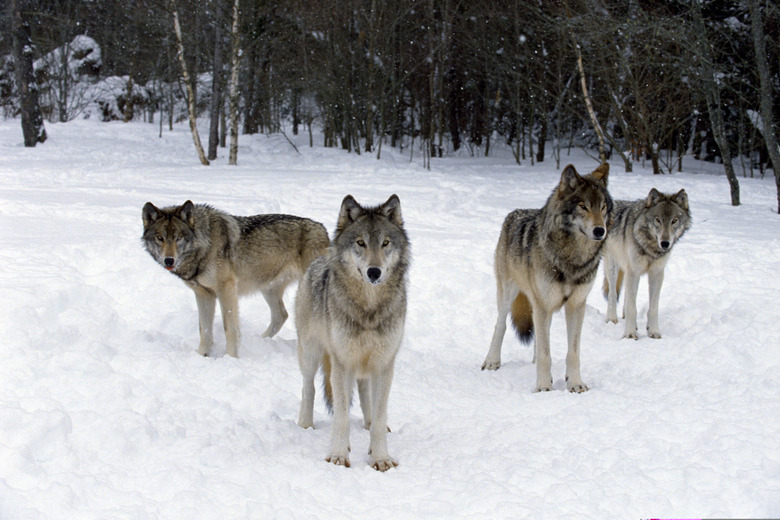Differences Between Wolves And Coyotes
Wolves and coyotes certainly have their similarities. When you aren't comparing them side by side you might have a hard time telling the difference between the two! Researchers place both species in the Canidae family, and they even classify both into the same taxonomic genus, Canis, as well! But how do you tell the difference between wolves and coyotes?
Differences Between Wolves and Coyotes
Differences Between Wolves and Coyotes
These two doglike mammals have a few distinguishing characteristics and differing behaviors that you can use to tell them apart. The most readily apparent difference between the two is their size – and often their coloration as well. Furthermore, wolves and coyotes also have different hunting habits and prey choices, as well as social behavior and structure.
Wolves vs. Coyotes: Size Differences
Wolves vs. Coyotes: Size Differences
Perhaps the primary difference between wolves and coyotes is their size. Wolves reach significantly larger sizes than coyotes do, both in weight and body frame. Coyotes measure between 29 and 39 inches long, while gray wolves measure 34 to 51 inches long. Their weight differential provides a more drastic comparison. Coyotes usually weigh a maximum of 46 pounds, while wolves can reach weights up to 176 pounds.
Color Difference Between Wolves and Coyotes
Color Difference Between Wolves and Coyotes
Coloration provides a more difficult comparison than size, as wolves and coyotes both feature a range of different coat colors. With that said, coyotes tend to lean more towards tan and sandy colorations, while wolves primarily feature whites, blacks or grays in their coat.
Coyote coloration tends to have gray undertones, with their base coat color ranging between yellow and brown. They also feature more reddish color around their faces, legs and feet.
The coat color of wolves varies more drastically than that of coyotes. Wolves can have coats of predominantly white, gray, black, brown or cinnamon coloration. They also tend to have darker black coloration along their back.
Social Differences Between Wolves and Coyotes
Though sometimes less visible to the casual observer, social structure within a group differs significantly between wolves and coyotes. Wolves have famously strict and cohesive packs, typically containing between five and nine individual animals. Some wolf packs can reach up to 36 individuals! Packs consist of a dominant breeding pair and their young from the previous years.
Unlike wolves, coyotes do not regularly form packs. These canines do sometimes remain in small family groups, but solitary animals and pairs are quite common. In coyotes, the amount of available prey determines if family groups remain together to hunt for prey as a group or not.
Hunting Habits of Wolves vs. Coyotes
Hunting Habits of Wolves vs. Coyotes
The social structure of these animals also impacts their hunting habits, as does their relative size. Because wolves maintain cohesive packs with more individuals, they can work together to hunt larger prey. They can also hunt larger prey because they grow to larger sizes than coyotes do.
Prey choice depends on where the animals live, but some of the different types of prey that wolves hunt include deer, bison, elk, moose and reindeer. The pack works together to separate, trap and overcome the weakest members of the herd, such as old or sick individuals. Wolves will also scavenge on animals that have already perished, and steal the kills of other predators such as bears or mountain lions.
Coyotes also scavenge for carrion, though they prefer eating fresh meat. Small mammals make up the bulk of their diet. Some common prey species include rabbits, mice, rats and squirrels. They also feed on birds, lizards, invertebrates, snakes and other small prey. Family groups and pairs will sometimes cooperate to hunt larger prey as well, such as deer.
Cite This Article
MLA
Zinni, Yasmin. "Differences Between Wolves And Coyotes" sciencing.com, https://www.sciencing.com/differences-between-wolves-coyotes-8193837/. 30 September 2021.
APA
Zinni, Yasmin. (2021, September 30). Differences Between Wolves And Coyotes. sciencing.com. Retrieved from https://www.sciencing.com/differences-between-wolves-coyotes-8193837/
Chicago
Zinni, Yasmin. Differences Between Wolves And Coyotes last modified March 24, 2022. https://www.sciencing.com/differences-between-wolves-coyotes-8193837/
